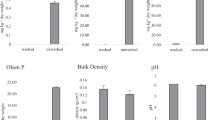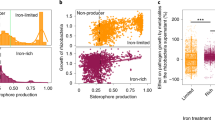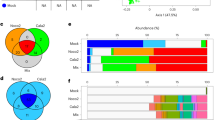Abstract
The complex structure and function of a plant microbiome are driven by many variables, including the environment, microbe–microbe interactions and host factors. Likewise, resident microbiota can influence many host phenotypes. Gnotobiotic growth systems and controlled environments empower researchers to isolate these variables, and standardized methods equip a global research community to harmonize protocols, replicate experiments and collaborate broadly. We developed two easily constructed peat-based gnotobiotic growth platforms: the FlowPot system and the GnotoPot system. Sterile peat is amenable to colonization by microbiota and supports growth of the model plant Arabidopsis thaliana in the presence or absence of microorganisms. The FlowPot system uniquely allows one to flush the substrate with water, nutrients and/or suspensions of microbiota via an irrigation port, and a mesh retainer allows for the inversion of plants for dip or vacuum infiltration protocols. The irrigation port also facilitates passive drainage, preventing root anoxia. In contrast, the GnotoPot system utilizes a compressed peat pellet, widely used in the horticultural industry. GnotoPot construction has fewer steps and requires less user handling, thereby reducing the risk of contamination. Both protocols take up to 4 d to complete with 4–5 h of hands-on time, including substrate and seed sterilization. In this protocol, we provide detailed assembly and inoculation procedures for the two systems. Both systems are modular, do not require a sterile growth chamber, and cost less than US$2 per vessel.
This is a preview of subscription content, access via your institution
Access options
Access Nature and 54 other Nature Portfolio journals
Get Nature+, our best-value online-access subscription
$29.99 / 30 days
cancel any time
Subscribe to this journal
Receive 12 print issues and online access
$259.00 per year
only $21.58 per issue
Buy this article
- Purchase on Springer Link
- Instant access to full article PDF
Prices may be subject to local taxes which are calculated during checkout






Similar content being viewed by others
Data availability
All data are presented in this paper are available from the authors without restrictions. Information about the input soil microbial communities is available in Supplementary Table 1. Raw source 16S rRNA gene sequences from this project (for Fig. 6 and Supplementary Table 2) are available in the Sequence Read Archive database under BioProject PRJNA689857, accession numbers SAMN17220890 to SAMN17220933.
References
Round, J. L. & Mazmanian, S. K. The gut microbiota shapes intestinal immune responses during health and disease. Nat. Rev. Immunol. 9, 313–323 (2009).
Chen, T. et al. A plant genetic network for preventing dysbiosis in the phyllosphere. Nature 580, 653–657 (2020).
Durán, P. et al. Microbial interkingdom interactions in roots promote Arabidopsis survival. Cell 175, 973–983.e14 (2018).
Busby, P. E. et al. Research priorities for harnessing plant microbiomes in sustainable agriculture. PLoS Biol. 15, e2001793 (2017).
Liu, Y.-X., Qin, Y. & Bai, Y. Reductionist synthetic community approaches in root microbiome research. Curr. Opin. Microbiol. 49, 97–102 (2019).
Bai, Y. et al. Functional overlap of the Arabidopsis leaf and root microbiota. Nature 528, 364–369 (2015).
Lebeis, S. L. et al. Salicylic acid modulates colonization of the root microbiome by specific bacterial taxa. Science 349, 860–864 (2015).
Zamioudis, C. et al. Rhizobacterial volatiles and photosynthesis‐related signals coordinate MYB 72 expression in Arabidopsis roots during onset of induced systemic resistance and iron‐deficiency responses. Plant J. 84, 309–322 (2015).
Finkel, O. M. et al. The effects of soil phosphorus content on plant microbiota are driven by the plant phosphate starvation response. PLoS Biol. 17, e3000534 (2019).
Innerebner, G., Knief, C. & Vorholt, J. A. Protection of Arabidopsis thaliana against leaf-pathogenic Pseudomonas syringae by Sphingomonas strains in a controlled model system. Appl. Environ. Microbiol. 77, 3202–3210 (2011).
Peiffer, J. A. et al. Diversity and heritability of the maize rhizosphere microbiome under field conditions. Proc. Natl Acad. Sci. USA 110, 6548–6553 (2013).
Spor, A., Koren, O. & Ley, R. Unravelling the effects of the environment and host genotype on the gut microbiome. Nat. Rev. Microbiol. 9, 279–290 (2011).
Adair, K. L. & Douglas, A. E. Making a microbiome: the many determinants of host-associated microbial community composition. Curr. Opin. Microbiol. 35, 23–29 (2017).
Xin, X.-F. et al. Bacteria establish an aqueous living space in plants crucial for virulence. Nature 539, 524–529 (2016).
Andrew, D. R. et al. Abiotic factors shape microbial diversity in Sonoran Desert soils. Appl. Environ. Microbiol. 78, 7527–7537 (2012).
Fierer, N. & Jackson, R. B. The diversity and biogeography of soil bacterial communities. Proc. Natl Acad. Sci. USA 103, 626–631 (2006).
Gunning, T. & Cahill, D. M. A soil-free plant growth system to facilitate analysis of plant pathogen interactions in roots. J. Phytopathol. 157, 497–501 (2009).
Jackson, M. B. et al. Ventilation in plant tissue cultures and effects of poor aeration on ethylene and carbon dioxide accumulation, oxygen depletion and explant development. Ann. Bot. 67, (1991).
Kloepper, J. W. & Schroth, M. N. Plant growth–promoting rhizobacteria and plant growth under gnotobiotic conditions. Phytopathology 71, 642–644 (1981).
Henry, A. et al. An axenic plant culture system for optimal growth in long-term studies. J. Environ. Qual. 35, 590–598 (2006).
Carlström, C. I. et al. Synthetic microbiota reveal priority effects and keystone strains in the Arabidopsis phyllosphere. Nat. Ecol. Evol. 3, 1445–1454 (2019).
Adams, C., Jacobson, A. & Bugbee, B. Ceramic aggregate sorption and desorption chemistry: implications for use as a component of soilless media. J. Plant Nutr. 37, 1345–1357 (2014).
Trevors, J. T. Sterilization and inhibition of microbial activity in soil. J. Microbiol. Methods 26, 53–59 (1996).
Shaw, L. J., Beaton, Y., Glover, L. A., Killham, K. & Meharg, A. A. Re-inoculation of autoclaved soil as a non-sterile treatment for xenobiotic sorption and biodegradation studies. Appl. Soil Ecol. 11, 217–226 (1999).
Bank, T. L. et al. Effects of gamma-sterilization on the physico-chemical properties of natural sediments. Chem. Geol. 251, 1–7 (2008).
Berns, A. E. et al. Effect of gamma-sterilization and autoclaving on soil organic matter structure as studied by solid state NMR, UV and fluorescence spectroscopy. Eur. J. Soil Sci. 59, 540–550 (2008).
Wolf, D. C., Dao, T. H., Scott, H. D. & Lavy, T. L. Influence of sterilization methods on selected soil microbiological, physical, and chemical properties. J. Environ. Qual. 18, 39–44 (1989).
Lotrario, J. B. et al. Effects of sterilization methods on the physical characteristics of soil: implications for sorption isotherm analyses. Bull. Environ. Contam. Toxicol. 54, 668–675 (1995).
Seedorf, H. et al. Bacteria from diverse habitats colonize and compete in the mouse gut. Cell 159, 253–266 (2014).
Lindsey, B. E. III, Rivero, L., Calhoun, C. S., Grotewold, E. & Brkljacic, J. Standardized method for high-throughput sterilization of Arabidopsis seeds. J. Vis. Exp. https://doi.org/10.3791/56587 (2017).
Clough, S. J. & Bent, A. F. Transformation of Arabidopsis thaliana. Plant J. 16, 735–743 (1998).
Acknowledgements
We thank C. Griffin, A. Bonifer, A. Mundakkal, F. Dion, T. Ulrich, J. Martz and T. Johnson for assistance with FlowPot assembly and workflow optimization, M. A. Hassani and S. Hacquard for critical reading and helpful comments on the manuscript, and B. Kvitko and J. P. Jerome for their contributions to FlowPot growth system development. Figure 2 was partially created with Biorender.com. This project was supported by funding from the Gordon and Betty Moore Foundation (GBMF3037), the National Institutes of Health (GM109928) and the Plant Resilience Institute, Michigan State University. P.S.-L. was supported by the Max Planck Society and the Deutsche Forschungsgemeinschaft (DFG, German Research Foundation) in the Priority Programme SPP 2125 DECRyPT.
Author information
Authors and Affiliations
Contributions
J.M.K., J.T. and S.Y.H. designed the FlowPot experiments. R.S. and S.Y.H. designed the GnotoPot experiments. J.M.K., R.S., B.P., D.R., C.T. and J.F. performed and/or analyzed the experiments. P.S.-L. supervised J.M.K. during FlowPot protocol optimization at Max Planck Institute for Plant Breeding Research, Cologne. J.M.K., R.S., B.P. and S.Y.H. wrote and finalized the manuscript with input from all coauthors.
Corresponding authors
Ethics declarations
Competing interests
The FlowPot system has the following patent: Methods and apparatus for gnotobiotic plant growth, J. Kremer, J. M. Tiedje, S. Y. He, US Patent 10,645,886 (2020). However, this patent did not influence the writing of this paper.
Additional information
Peer review information Nature Protocols thanks Corné Pieterse and the other, anonymous, reviewer(s) for their contribution to the peer review of this work.
Publisher’s note Springer Nature remains neutral with regard to jurisdictional claims in published maps and institutional affiliations.
Related links
Key references using this protocol
Durán, P. et al. Cell 175, 973–983 (2018): https://doi.org/10.1016/j.cell.2018.10.020
Chen, T. et al. Nature 580, 653–657 (2020): https://doi.org/10.1038/s41586-020-2185-0
Supplementary information
Supplementary Information
Supplementary Methods.
Supplementary Table 1
Geographic locations of soils used in this study
Supplementary Table 2
OTU information for the example community profiling workflow used to generate the heatmap in Fig. 6
Rights and permissions
About this article
Cite this article
Kremer, J.M., Sohrabi, R., Paasch, B.C. et al. Peat-based gnotobiotic plant growth systems for Arabidopsis microbiome research. Nat Protoc 16, 2450–2470 (2021). https://doi.org/10.1038/s41596-021-00504-6
Received:
Accepted:
Published:
Issue Date:
DOI: https://doi.org/10.1038/s41596-021-00504-6
This article is cited by
-
Chromosomal barcodes for simultaneous tracking of near-isogenic bacterial strains in plant microbiota
Nature Microbiology (2024)
-
The Arabidopsis holobiont: a (re)source of insights to understand the amazing world of plant–microbe interactions
Environmental Microbiome (2023)
-
Genome-resolved metatranscriptomics reveals conserved root colonization determinants in a synthetic microbiota
Nature Communications (2023)
-
A critical role of a eubiotic microbiota in gating proper immunocompetence in Arabidopsis
Nature Plants (2023)
-
Plant commensal type VII secretion system causes iron leakage from roots to promote colonization
Nature Microbiology (2023)
Comments
By submitting a comment you agree to abide by our Terms and Community Guidelines. If you find something abusive or that does not comply with our terms or guidelines please flag it as inappropriate.



